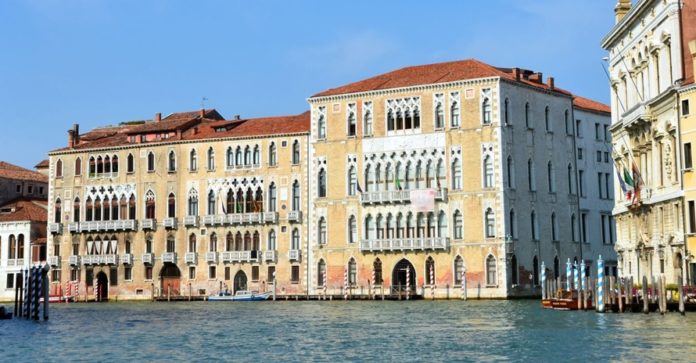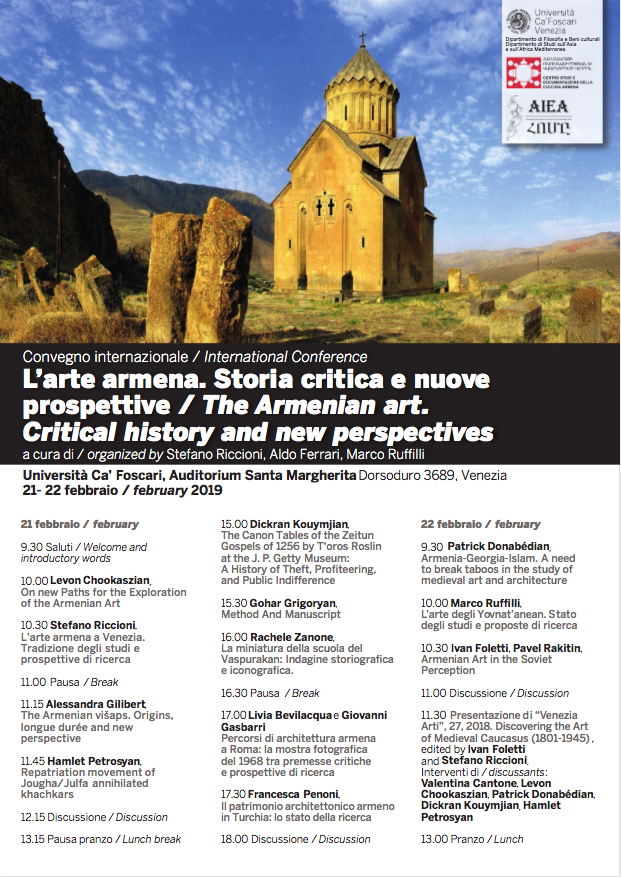Scholars in Venice Conduct a Journey through Armenian Art
Mar/27/2019 Archived in:Culture

Ca’ Foscari university
by Muriel Mirak-Weissbach
VENICE, FEBRUARY 28, 2019 — Venice has a long history of relations with Armenia, which most people associate with the Mekhitarist monastery on the island of San Lazzaro, with its imposing church and magnificent library. But Venice also hosts an important center of Armenian studies, at the Ca’ Foscari university, which has a Chair for Medieval Art History and for Armenian Language and Literature. On February 21-22, the university, in collaboration with the Center for Studies and Documentation of Armenian Art and the Association Internationales des Études Arméniennes, hosted an international conference on “Armenian Art: Critical History and New Perspectives.”
Gathering specialists from Armenia, France, Germany, the Czech Republic and Italy, the conference aimed at providing new impetus for Armenian studies, in a venue associated with the names of such renowned past experts as Paolo Cuneo, Adriano Alpago Novello and Gianclaudio Macchiarella. The Ca’ Foscari university, continuing its mission as a center for cultural encounter, seeks to place new emphasis on the study of Armenian art in the Venetian context.
“The relationship between Venice and the Armenians in intense and fruitful,” Aldo Ferrari, professor of Armenian Language and Literature explained. “In the course of centuries Armenians have lived in the city as merchants, pilgrims, monks, printers and artists. It is no coincidence,” he went on, “that the first book printed in Armenian was published in Venice, back in 1512. In 1717, the Venetian Republic, known as La Serenissima, gave permission to the monastic congregation of Abbot MeKhitar to settle on the island of Lazzaro and thus to begin an extraordinary experience which provided the impetus for the cultural renaissance of the Armenian people.” And, he added, “also in Venice, the Moorat Raphael college was established, where a significant part of the Armenian cultural elite studied to the end of the 20th century.”
Ca’ Foscari inaugurated its chair for Armenian Language and Literature in 1976. The study of Armenian art, which is located here, represents an extraordinary patrimony that has ignited the enthusiasm of all those who have come into contact with it. “Already back in 1988,” Medieval Art historian Prof. Stefano Riccioni recalled, “Prof. Levon Zekiyan organized an important international conference on Armenian art. The following year, Prof. Adriano Alpago Novello began his course in Armenian Art and Architecture at Ca’ Foscari. In 1991, Novello transferred the Center for Study and Documentation of Armenian Culture, from Milan to Venice. And still today, this Center, under the direction of Minas Lourian, organizes several events on Armenian art, often in collaboration with Ca’ Foscari and the Biennale of Venice. Among the activities of the center are the Manukian Lectures, organized in collaboration of another important scholar who passed away recently, Prof. Gianclaudio Macchiarella.”
For the past five years, the seminars of Armenian art at Ca’ Foscari have been organized by Stefano Riccioni, Aldo Ferrari and Marco Ruffilli, in the Department of Studies on Asia and Mediterranean Africa (which hosts the Chair for Armenian Language and Literature). The same three scholars organized this year’s conference, which presented advanced research projects in various aspects of Armenian art, from architecture to miniatures, from khachkars to painting.
Following a lecture by Levon Chookaszian on “New Paths for the Exploration of Armenian Art,” Riccioni spoke about “Armenian Art in Venice – Tradition and Research Perspectives.” Attention was dedicated also to the “vishap,” the famous prehistoric stones characteristic of Armenia, which have been the subject of study in the Ca’ Foscari’s Dragon Stones Archaeological Project. Alessandra Gilibert introduced the origins and long history of the visaps and Hamlet Petrosyan spoke on “The Repatriation Movement of Jougha/Julfa annihilated khachkars.”h
The conference addressed several heated issues, like the fate of the Armenian artistic heritage in hostile political environments; Francesca Penoni discussed the current state of research related to the Armenian architectonic patrimony in Turkey. And with regard to literary works, Dikran Kouymjian spoke on “The Canon Tables of the Zeitun Gospels of 1256 by T’oros Roslin at the J.P. Getty Museum; A History of Theft, Profiteering and Public Indifference.”
Gohar Grigoryan presented a paper on “Method and Manuscript,” followed by Rachele Zanone, who presented a historiographical and iconographc study of the miniature art of Vaspurakan.
Patrick Donabedian delivered a lecture on “Armenia-Georgia-Islam: A need to break taboos in the study of Medieval art and architecture.” Marco Ruffilli discussed spoke on “The art of the Yovnat’anean – current status and research proposals.” Ivan Foletti and Pavel Rakitin concluded with a discussion of Armenian art in the Soviet perception.
The new book, Discovering the Art of Medieval Caucasus (1801-1945) was the subject of a round table discussion that completed the conference proceedings. Published in “Venezia Arti”, volume 27 (2018), the study was edited by conference participants Ivan Foletti and Stefano Riccioni.
As Riccioni pointed out, this conference is to be seen as the first in a series of international meetings on the theme of Caucasian art, which is part of an international research project, “Seminarium Caucasicum. Studies in Art on Medieval Caucasus (And Beyond),” directed by Michele Bacci (University of Fribourg), Ivan Foletti (Masaryk University) and Stefano Riccioni (Ca’ Foscari University of Venice). The project promotes regional discussions dedicated to the arts of the region and the conservation and care of their artistic heritage.


